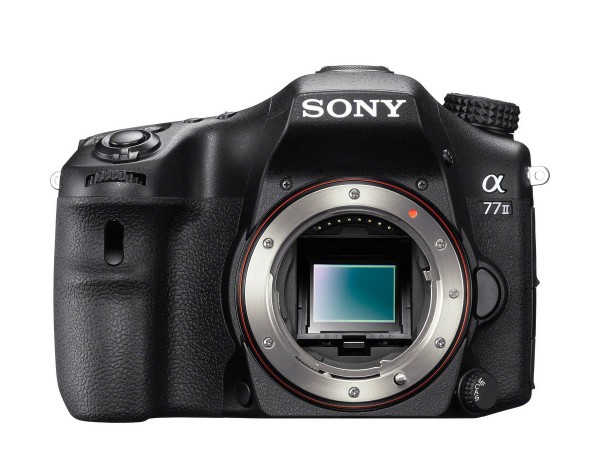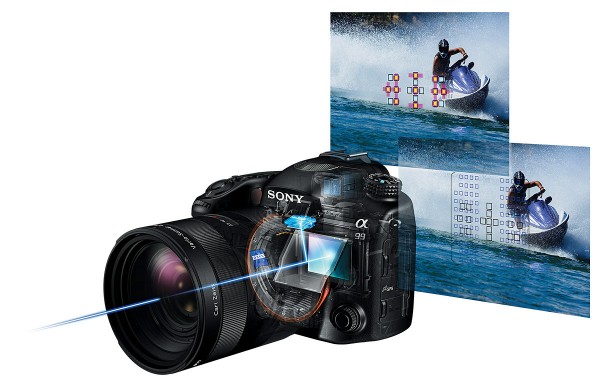Posted by Photo-John on June 25, 2014
Sony recently announced a new high-performance crop-sensor DSLR-style camera that has me seriously thinking about trading in one of my Canon bodies. The Sony Alpha A77 II action DSLR is the follow-up to the SLT-A77 introduced in 2011 and offers a level of performance we haven’t seen yet in an APS-C sensor DSLR – especially for action shooters like myself. No doubt some of you will read this as blasphemy, but I think the A77 II may be the Canon EOS 7D replacement I’ve been waiting for.
Over the past two or three years, I’ve become a bit of a Sony camera fanboy. I like Sony’s “SLT” DSLR-style cameras enough that last year I wrote an article entitled, Why Your Next DSLR Should Be a Sony. I’m not ready to bail on Canon yet, though. Canon and Nikon still make the best professional sports DSLRs on the planet and that makes it hard to completely switch. But I do believe Sony is the most creative camera maker right now. And if the A77 II performs as promised, I think I’ll have to have one. Luckily for me, a camera is already on the way, thanks to my new relationship with Imaging-Resource, who I am now writing for. Because I’m an action shooter, they decided I’m the right person to review the A77 II. That means I get a dry run with the camera before I have to make a decision and cough up my own hard-earned money.

The A77 II has a 24.3-megapixel APS-C sensor and Sony’s BIONZ X image processing for sensitivity to ISO 25,600.
So what’s the big deal with the Sony Alpha A77 II? First of all, Canon hasn’t really updated their APS-C sensor since the EOS 7D was introduced way back in 2009. That’s right – if you buy a crop-sensor Canon DSLR right now, you’re basically shooting with a five-year-old sensor. Sony is providing the sensors used in most competing cameras now and they’ve been making consistent improvements over the past few years. Canon has improved their processing but that only makes a difference for video and JPEGs, which are processed in the camera. Since I’m exclusively a RAW shooter, Canon’s improved processing doesn’t mean a thing to me. But based on my experience with cameras using Sony APS-C sensors, I think it’s reasonable to expect a two-stop improvement in RAW image quality with the A77 II, compared to my Canon APS-C sensor cameras. ISO 1600 is as far as I’m willing to push the EOS 7D. I’m hoping for useable ISO 6400 sensitivity from the A77 II. If it actually performs at that level, it will be huge for me.

Rear view of the A77 II digital SLR, with 3-inch tilt-swivle LCD display and OLED electronic viewfinder.
The A77 II’s action performance features and specs are also excellent. It’s an absolute class leader in that respect – I wouldn’t be interested if it wasn’t. The A77 II can shoot full-resolution bursts at up to 12 frames per second for 60 frames (JPEG, only). It has a new 79-point phase-detect auto focus system with 15 extra-sensitive (for your pleasure) cross-type sensors in the middle of the frame. That’s better even than the Nikon D4S and Canon EOS-1D X professional DSLRs, which have 51 and 61 AF points, respectively. This is a great example of Sony’s aggressive camera design and pricing. For Sony to offer that kind of spec in a $1200 camera body is very impressive – if it performs.

The new Sony Alpha A77 II uses Sony’s Translucent Mirror Technology for superior auto focus performance for video as well as still photos.
The A77 II and Sony’s other Alpha SLT cameras benefit from Translucent Mirror Technology, which allows you to use the same auto focus system for video as well as still photos. They’re the only camera company that uses this design and it offers very real benefits – especially for videographers. The A77 II also has an EVF (electronic viewfinder) instead of a traditional optical viewfinder like other DSLRs. The quality of EVFs has improved a lot over the past few years and I now prefer them to optical viewfinders in most situations – especially for recording video. With a normal DSLR you can’t use the eye-level viewfinder when you’re recording video. That means you need to buy (and carry) an expensive accessory viewfinder to help steady the camera and make it possible to see what you’re recording in bright light. With the Sony SLT cameras, that video viewfinder is built right in. You can also play back photos and videos in the EVF, see the histogram, menus, and all other info you’d normally have to look at the LCD display to see.
I will reserve judgment about the auto focus and burst rate until I get the camera in my hands. I’m a manual exposure, RAW shooter and the A77 II’s top burst rate is only in JPEG mode; and only with their special AF-C auto mode, which prioritizes for speed and doesn’t allow the photographer to adjust ISO, shutter speed or aperture. As I understand it, the A77 II can shoot RAW bursts in manual modes at 10 FPS, though. That is plenty quick – two frames faster than the Canon EOS 7D I usually use. I don’t know how the buffer is, though. That’s definitely one of the first things I’m going to test when the camera arrives – how many RAW frames can I shoot before the camera’s buffer is full and it has to stop or slow to save to the memory card. Auto focus performance remains to be seen, as well. As a camera reviewer, I’ve learned to take all auto focus claims with a grain of salt. While the A77 II’s auto focus system looks stellar on paper, I’ll have to see how it performs in the real world before I pass judgment. For me, that means shooting some high-speed mountain bike action. I have high hopes for the A77 II. But when it comes to continuous auto focus, the Canon EOS 7D and 70D are very stiff competition.
The A77 II also has built-in Wi-Fi – something a lot of people still don’t understand. Basically, it allows you to share photos you take with the camera, immediately, via your Smart Phone. You don’t need an external Wi-Fi network to use it, either. The camera creates its own network and allows you to wirelessly transfer photos and videos to your phone or a tablet, where you can process and share them via whatever apps you want. I’ve been using in-camera Wi-Fi for a couple of years now and don’t want to live without it anymore. It’s become a critical part of my photo workflow. I’d say 99% of the photos I share on my Instagram account are made with camera’s that have built-in Wi-Fi. I almost never use the camera in my Smart Phone. Smart Phone cameras just don’t offer the quality, optics or control I want.
Let’s summarize: Sony’s new Alpha A77 II camera has an electronic viewfinder, a new 79-point phase detect AF system, a translucent mirror design that allows continuous phase detect auto focus for video as well as still photos, a 24-megapixel APS-C sensor, built-in sensor-shift image stabilization, Sony’s top-of-the-line BIONZ X processor, full HD 60p video, up to 12 frames per second high-speed burst, a tilt-swivel LCD display, and built-in Wi-Fi. It certainly looks better than my EOS 7D, on paper. I should have it in my hands no later than next Monday and possibly by the end of this week. If you want to follow my photos and thoughts on the camera as I’m using it, “Like” my Photo-John page on Facebook. I’ll definitely be posting about it there. And after I get to know it, my Shooter’s Report will be added to the full Sony Alpha A77 II review on Imaging-Resource.
The Sony Alpha A77 II is available now. It’s available body-only for US $1200; or in a kit with Sony’s 16-50mm f/2.8 zoom lens for $1800.